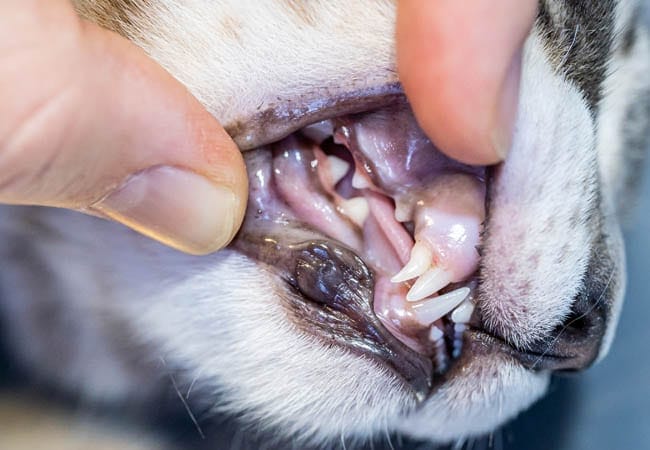What is a retained baby tooth?
A retained tooth is a baby tooth that remains in place after the adult tooth has erupted which can lead to a range of problems. Normally the baby tooth will fall out before the adult tooth erupts.
Key points
- In some kittens, a baby tooth will remain in place after the adult tooth erupts.
- If this occurs, speak to your veterinarian.
- If the tooth doesn’t fall out on its own, it may be necessary to remove it, so that the adult tooth can erupt in its correct position.
The teething process
Both sets of teeth form during fetal development and are present in the gums at birth. The adult teeth buds are in the gums, beneath the baby teeth. As we know, the kitten initially has a set of baby teeth, which is very smart of mother nature, a kitten’s jaw is not large enough to accommodate fully developed adult teeth, which is why the smaller baby teeth erupt first. As the adult teeth in the gums enlarge (around the time of teething), they press on the roots of the baby teeth, which stimulate cells called osteoclasts to reabsorb the tooth root, which cause it to fall out.
Kittens can experience some discomfort during teething, such as:
- Drooling
- Chewing on hard objects
- Reluctance to eat
- Bad breath
- Red gums
Retained baby teeth

A baby tooth is considered to be retained if an adult tooth erupts before the baby tooth has fallen out, this is sometimes referred to as shark teeth. The most commonly affected teeth are the upper canines (fangs), followed by the lower canines. Retained baby teeth can cause several problems, including:
- Crowding can displace the permanent teeth, causing them to erupt crooked
- Crooked teeth can lead to malocclusion of the jaw (incorrect bite)
- Food can be trapped between the teeth, causing decay, gum disease can develop due to excess plaque formation on the surrounding teeth.
- Misaligned teeth can rub against neighbouring teeth and wear them down over time
- If the bottom canines are involved, a retained tooth can push the erupting tooth forward, and instead of fitting snugly behind the upper canine, it hits the roof of the mouth, if the upper canines are involved, they can press down onto the gums, causing damage to the roof of the mouth or infection
Is it possible to prevent retained baby teeth in cats?
No, but if it occurs, immediate treatment is necessary so that the adult tooth can erupt in its correct position.
What are the symptoms of a retained baby tooth in cats?
- Two teeth in the same position (see image)
- Misalignment of an erupted adult tooth
- Bad breath
- Red gums
Diagnosis

Image credit, @cat-yawns
A thorough oral examination to evaluate the teeth.
Diagnostics:
Dental x-rays to ascertain which are the baby and adult teeth as well as determine if the baby tooth still has the root attached inside the gum.
Treatment
Removing the baby tooth will be necessary. In many cases, this is already loose and will be easy to remove. Otherwise, surgical extraction will be required.

